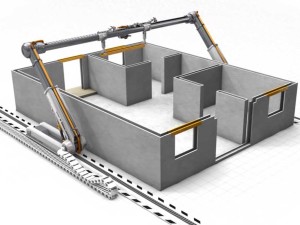
By: Jamie Fettkether: President, Lockard Construction
Technology is changing the way construction professionals manage projects, and it’s also having a profound impact on the preparation and actual building processes. Firms that can harness the power new technology offers may therefore have a competitive edge in the overall bidding process by being able to reduce timeframes and lower costs.
Below are seven examples of how technology is transforming the construction industry:
3D printing. The miracle of 3D printing has the potential to drastically reduce the time it takes to produce complex building forms. The technology is also being used to prefabricate and install components such as mechanical equipment and plumbing. Some in the industry are even using it to perform drywall detailing. The use of 3D printing won’t stop there: It’s already being experimented with to build entire homes.
Drones. While drones are getting a bad rap for interfering with aviation and entering no-fly zones near the White House, they are also becoming useful tools in the construction process. Equipped with high-resolution digital cameras and advanced software, these machines are making the survey process much less cumbersome and time-consuming. They also allow subcontractors working on large projects to obtain aerial analysis so they can make better informed decisions about architectural and design elements of a building.
Building Information Modeling. Building information modeling (BIM) allows developers to create 3D models of buildings using the relevant construction data. There’s almost no limit to this capability; you can build a 3D model of an office complex, school or hospital in great detail, down to where doors are located. This allows the teams involved to see any potential issues with the construction process before the first forms are erected.
Software for faster energy modeling. Energy modeling has always been a time-consuming exercise. New software tools are changing that by allowing analysis during conceptual design. This replaces the single-purpose models such as daylighting and airflow models that can take weeks to build and run. Designers can analyze performance data in hours and quickly alter their designs if needed.
Mobile technology in the field. The construction industry continues to find new uses for mobile apps and cloud computing as a way to manage projects more efficiently.
Foremen and project managers are ditching paper time cards in favor of mobile apps that can capture workers’ hours, thus cutting down on mistakes. The same technology allows them to instantly analyze daily production, which gives them ability to make changes immediately rather than waiting days or weeks for information to become available.
Project managers will continue to see paper disappear from construction sites. Drawings, change orders, claims and other types of common paperwork are now being transmitted from the office to the job site using integrated applications. Cloud technology allows this information to be available to all authorized personnel regardless of location. Storing information digitally also reduces the problems of referring to outdated documents as current versions are centralized and readily available.
Equipment management technology. In addition to labor and materials, the use of equipment is a major expense in the construction process. To save on costs, project managers are using GPS tracking to not only monitor the location of equipment, but also how it’s being used. This can inform managers if an assets enters a prohibited location, or it’s being used improperly. The data can also be used to compare how a piece of equipment is being used on different job sites.
In another development related to equipment management, there’s speculation that the Uber model used by people to find taxi-like services throughout an area could evolve for use in the construction industry. This means a project manager could make a few clicks and order or return a piece of equipment with little hassle.
Near-Field Communications (NFC) is a secure form of data exchange between physical tags and NFC enabled devices. For construction purposes, it’s being used increasingly to track materials. For example, when a shipment of prefabricated materials is delivered to a job site, NFC data could immediately inform personnel on site if there are mistakes with the order, allowing them to rectify the problem much sooner.
